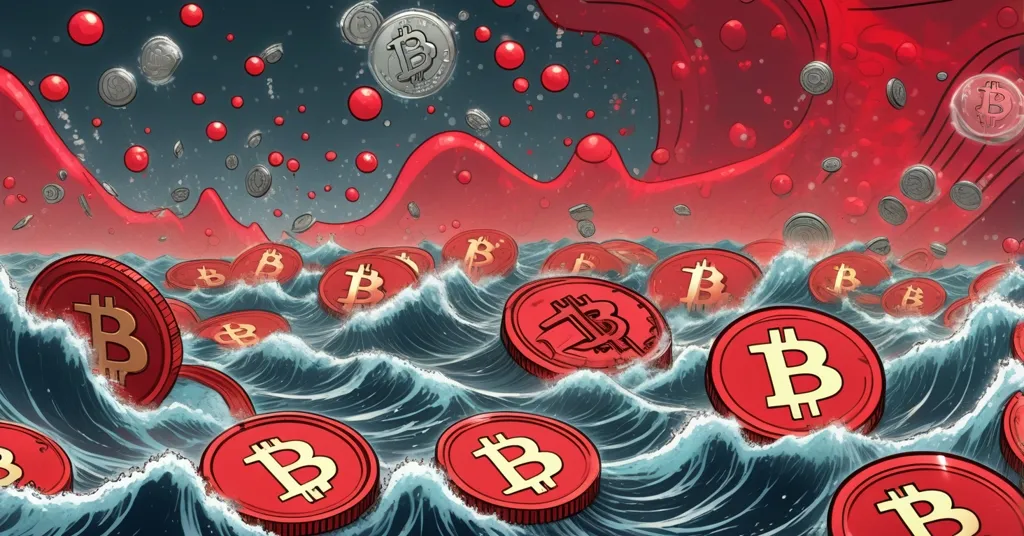Altcoin Crash: Cardano Down 10%, Solana Plunges 18%, Digitap Hypes 50x Gains

Altcoin Carnage: Cardano ($ADA) Dives 10%, Solana ($SOL) Crashes 18%, While Digitap ($TAP) Sparks 50x Hype
A massive $1.7 billion liquidation event has rocked the crypto market, sending major altcoins like Cardano ($ADA) and Solana ($SOL) into a tailspin with losses of 10% and 18%, respectively. As established tokens bleed value, speculative buzz is building around presale project Digitap ($TAP), touted as the “world’s first omni bank” with wild claims of 50x growth potential. Let’s cut through the chaos and dissect what’s really happening in this brutal market shakeout.
- Market Meltdown: $1.7B liquidation sparks panic selling across crypto.
- Cardano’s Woes: 10% drop tied to slow DeFi and NFT ecosystem growth.
- Solana’s Slump: 18% decline from profit-taking despite strong tech.
- Digitap Buzz: Presale token promises banking revolution and huge gains.
Market Meltdown: $1.7 Billion Liquidation Shock
The crypto space just got hit with a sledgehammer. A staggering $1.7 billion liquidation event—where overleveraged traders are forced to sell assets to cover losses, often triggering broader market declines—has unleashed a wave of panic selling. This kind of cascade exposes the raw underbelly of crypto’s leveraged trading culture, where margin calls amplify downturns like a house of cards collapsing. It’s not just a random blip; it’s a stark reminder of systemic risks baked into the market. Could tighter exchange policies or decentralized lending protocols prevent future bloodbaths? That’s a debate worth having, but for now, the damage is done, and altcoins are bearing the brunt.
Cardano’s Growing Pains: A 10% Nosedive
Cardano ($ADA), one of the veteran smart contract platforms, has taken a brutal 10% hit in recent days. For those new to the game, Cardano is a blockchain built on rigorous academic research, designed to rival Ethereum with a scalable, energy-efficient framework for decentralized applications (dApps) and smart contracts. It’s got a loyal developer community and a methodical approach, often dubbed “slow and steady.” But the market isn’t feeling patient right now. Investors are growing frustrated with sluggish ecosystem growth, especially in hot sectors like decentralized finance (DeFi) and non-fungible tokens (NFTs). To put it in perspective, Cardano’s DeFi total value locked (TVL)—the amount of assets staked or locked in a blockchain’s DeFi protocols, reflecting ecosystem activity—lags far behind competitors like Ethereum and Solana, with only a fraction of the billions seen on rival chains, according to DeFiLlama data.
Liquidity woes and stagnant prices only deepen the doubts. Some argue Cardano is just a slow-burn project needing time to mature—its Ouroboros proof-of-stake consensus mechanism is innovative, prioritizing sustainability over speed. Others see a platform failing to capitalize on years of hype, stuck in a cycle of overpromise and underdelivery. As Bitcoin maximalists, we admire the ambition to decentralize, but let’s be real: if Cardano can’t attract dApp developers or mainstream adoption soon, it risks fading into irrelevance. The market’s current verdict? A harsh sell-off, and it’s not pretty.
Solana’s Volatile Ride: An 18% Collapse
Solana ($SOL), the high-speed blockchain often celebrated for its lightning-fast transactions and dirt-cheap fees, couldn’t escape the carnage either. After hitting a peak of $240 in a recent rally, $SOL cratered 18%, slipping below $200 as profit-taking swept through the market. For context, Solana is built to process thousands of transactions per second, making it a favorite for DeFi protocols and NFT marketplaces. But this drop isn’t random—it’s tied to overbought conditions, where a token’s price spikes too fast, prompting traders to cash out gains. Reduced institutional inflows and lingering bad vibes from past network hiccups don’t help either.
Let’s not forget Solana’s rocky history—multiple outages in 2021 and 2022, including a 17-hour shutdown in September 2021 due to transaction overload, dented investor trust hard. Even with later upgrades, those ghosts still haunt sentiment. Yet, credit where it’s due: Solana’s fundamentals—like sub-second transaction finality—remain a powerful draw for developers. The question is whether it can rebuild confidence around scalability or if this slump is just another pothole on the highway to dominance. Volatility like this is a gut check, but for long-term holders, it might be a buying dip—if you’ve got the stomach for it.
Digitap ($TAP): Presale Promise or Dangerous Hype?
As $ADA and $SOL holders reel from losses, some are turning to untested waters with presale projects like Digitap ($TAP). For the unversed, a presale is an early funding stage where investors snag tokens at a fixed, often discounted price before they hit public exchanges—think of it as betting on a startup with sky-high rewards but equally sky-high risks of flop or fraud. Digitap brands itself as the “world’s first omni bank,” aiming to blend fiat and crypto banking into a seamless platform. Targeted at digital nomads and globetrotters, it boasts integrations with payment giants like Visa, Apple Pay, and Google Pay. At a starting price of $0.0125 per token, $TAP dangles incentives like staking rewards—earning interest by holding tokens—and buyback-and-burn mechanisms, where the project repurchases and destroys tokens to potentially boost value by reducing supply.
The vision is enticing: imagine buying a coffee in Tokyo with crypto, instantly converted to yen via a $TAP-powered app, no centralized bank needed. Since presale pricing isn’t tied to volatile exchange markets, tokens like $TAP are temporarily insulated from the downturns hammering established coins. This, paired with whispers of potential 50x growth post-listing, is why speculative capital is flowing in. It’s a familiar trend—when mature assets falter, investors chase the “next big thing” hoping to catch lightning in a bottle. For more on the buzz surrounding projects like Digitap and their speculative potential, check out this detailed analysis on Cardano, Solana, and Digitap’s market dynamics.
But hold your horses—let’s slam the brakes on this hype wagon. Projections of 50x returns are pure fantasy at this point. There’s no hard data, no proven track record, and no audited code to back such claims. Frankly, it stinks of the shameless shilling that infests this space, luring in dreamers only to leave them broke. Digging deeper raises more alarms: Digitap’s whitepaper touts Visa integration, but where’s the proof of partnerships? Transparency on token allocation is nonexistent—how much $TAP goes to developers versus public investors? Without answers, the specter of a rug pull—where founders cash out and disappear—looms large.
Look back at the 2017 ICO craze for a reality check. Countless projects promised the moon, only to vanish with millions in investor funds. Even legit presales face massive hurdles—building an omni-bank demands regulatory savvy, technical chops, and widespread adoption, barriers most startups never cross. Sure, early Ethereum presales showed what’s possible when vision meets execution, turning early backers into millionaires. But for every Ethereum, there are dozens of flops. Digitap could be a disruptor, or it could be another empty shell. If you’re tempted, do your damn homework—vet the team, demand audits, and never bet more than you can lose. This is the Wild West of finance, and not every gunslinger makes it out alive.
Bitcoin’s Bedrock Amid Altcoin Chaos
While altcoins swing wildly in this $1.7 billion storm, it’s worth noting Bitcoin’s role as the ultimate anchor for many long-term holders. As maximalists, we see BTC as the gold standard of decentralized money—a store of value that doesn’t bend to every market whim. Sure, it’s not immune to downturns, but its relative stability and battle-tested network often stand in stark contrast to the rollercoaster of altcoin speculation. Bitcoin doesn’t promise flashy dApps or banking revolutions; it delivers unshakeable freedom from centralized control. That’s the benchmark we measure everything else against, even as we recognize the experimental value altcoins and presales bring to the table.
What’s Next for Crypto’s Wild Ride?
This market saga lays bare crypto’s bipolar nature: battle-hardened projects like Cardano and Solana absorb heavy blows, reflecting the harsh truth of cycles and sentiment, while unproven newcomers like Digitap dangle the lure of explosive gains. It’s stability versus speculation, utility versus empty promises. For Cardano, a recovery might hinge on tangible DeFi growth or a killer app to ignite adoption—watch for upcoming protocol upgrades like Hydra for scalability. Solana’s path likely depends on proving network reliability; another outage could be fatal to confidence, but sustained developer activity could cement its comeback. As for Digitap, the presale space remains a gamble—look for red flags like delayed roadmaps or silent teams as early warnings.
Beyond individual projects, this $1.7 billion liquidation exposes deeper cracks in crypto’s foundation. Leveraged trading amplifies crashes, and until exchanges or protocols address this, expect more pain. Broader economic pressures, like rising interest rates squeezing risk assets, could prolong the bleed too. Yet, for every downturn, there’s opportunity—Bitcoin leads the charge for decentralization, altcoins push boundaries in their niches, and presales test our appetite for risk. As champions of freedom and disruption, we’re all in for accelerating this financial revolution. But let’s keep our wits sharp and not fall for every shiny pitch. The future of money is being forged—stay skeptical, stay savvy.
Key Takeaways and Burning Questions
- What caused the brutal price drops for Cardano and Solana?
A $1.7 billion liquidation event, where overleveraged positions were forcibly sold off, triggered widespread panic selling. Cardano fell 10% due to slow ecosystem growth in DeFi and NFTs, while Solana dropped 18% from profit-taking after a recent rally. - Is Cardano doomed to fail with these struggles?
Not yet—its slow DeFi and NFT adoption hurts, but a strong developer base and research-driven approach could still yield results if patience and innovation align. - Can Solana bounce back from this steep decline?
Probably, thanks to its superior speed and low fees, but rebuilding trust after past network outages and managing volatility are critical challenges ahead. - Is Digitap ($TAP) a legit opportunity with its 50x growth talk?
Doubtful at best—the omni-banking concept and payment integrations sound promising, but such growth claims are baseless without data or transparency, reeking of overhyped shilling. - Should investors chase presales like $TAP during downturns?
It’s a risky bet; presales offer potential upside and diversification, but they’re unproven, often fail, and carry high scam potential compared to established tokens. - How does Bitcoin fit into this altcoin chaos?
As the bedrock of decentralized value, Bitcoin often weathers storms better than altcoins, reinforcing its role as a safe haven for many while others experiment with riskier assets.



